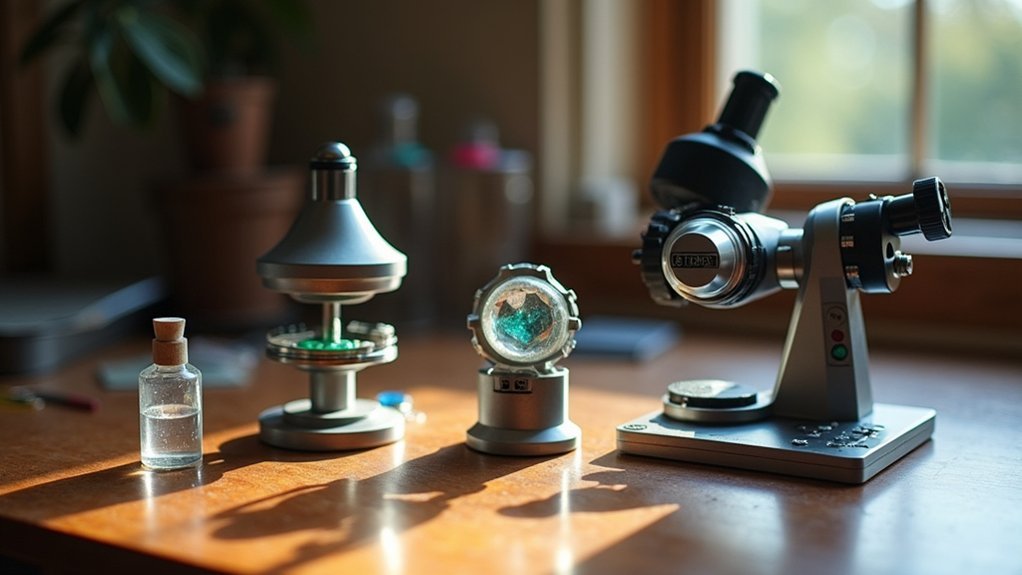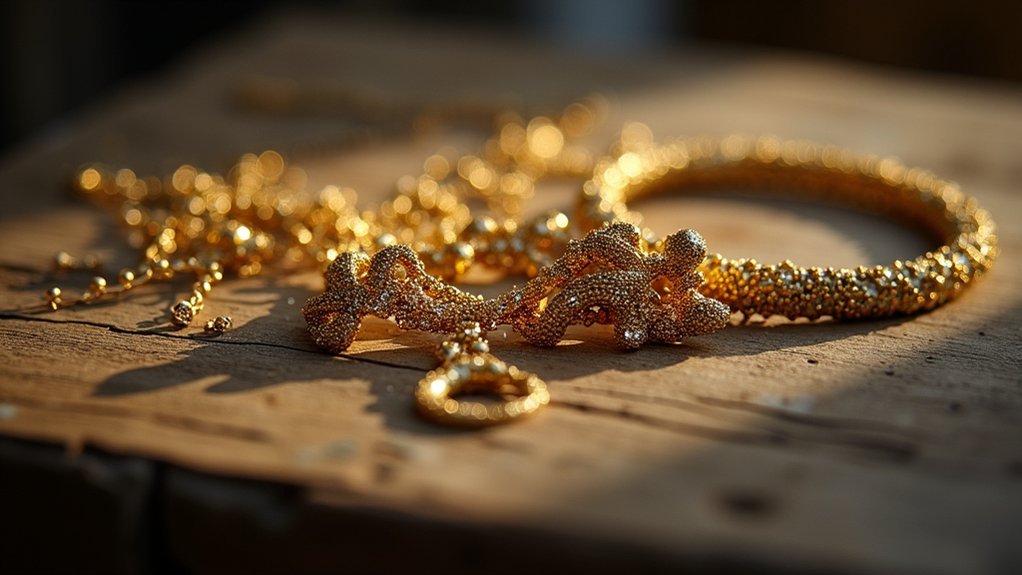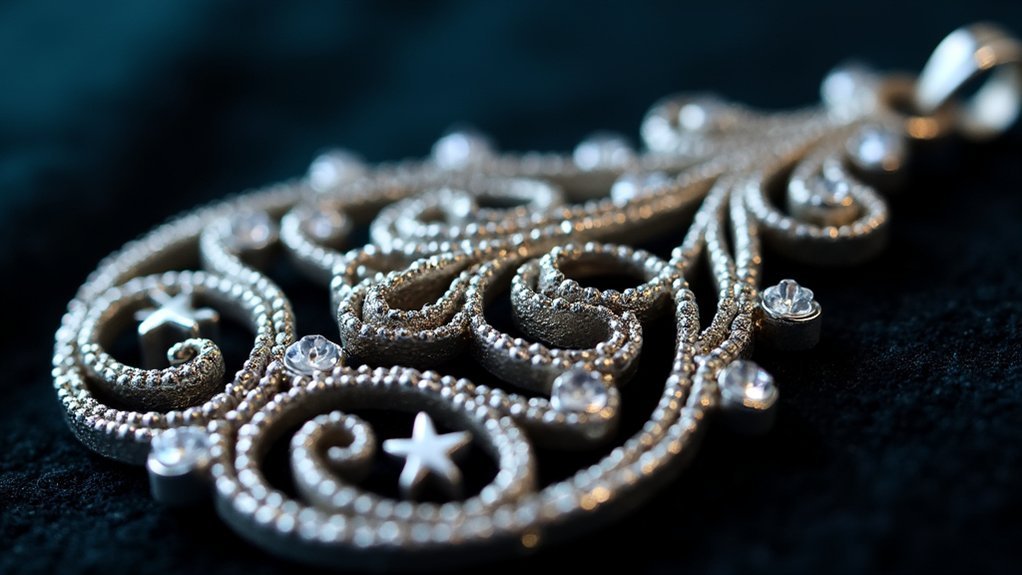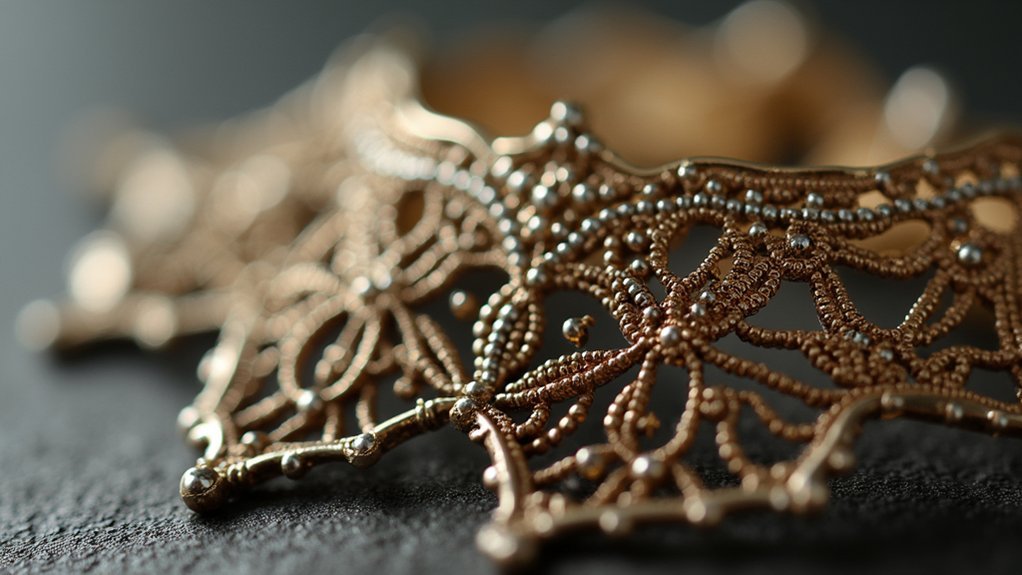You’ve started your journey into lapidary work and now face the challenge of properly identifying your gemstones. Without reliable testing tools, you might mistake a valuable find for common glass or confuse similar-looking stones. The right equipment makes all the difference between amateur guesswork and confident identification. Discover which three essential testing tools should be in your kit to elevate your lapidary skills and protect yourself from costly mistakes.
Presidium Gem Tester II (PGT II) for Diamond and Gemstone Identification
Gemstone enthusiasts and jewelry professionals looking for a versatile testing tool will find the Presidium Gem Tester II (PGT II) an essential addition to their toolkit. This compact device identifies diamonds, moissanites, and 16 common colored gemstones through thermal conductivity testing.
You’ll appreciate the industry’s thinnest retractable probe tip and self-calibration functionality through Assisted Thermal Calibration. While users report 100% accuracy after proper calibration, you’ll need a gentle touch to master it.
Best For: Jewelry professionals, gemologists, and gemstone collectors seeking a portable and reliable tool for initial identification of diamonds and common gemstones.
Pros:
- Identifies diamonds, moissanites, and 16 common colored gemstones with consistent accuracy when properly calibrated
- Features the industry’s thinnest retractable probe tip and Assisted Thermal Calibration for easy self-calibration
- Compact, sturdy design makes it portable for use in various settings
Cons:
- Cannot differentiate between lab-created and natural gemstones
- Doesn’t test opals or organic stones, limiting its comprehensive testing capability
- Some users report calibration difficulties and potential quality issues with units malfunctioning after limited use
Diamond Tester Pen with 60X Jewelry Loupe Magnifier
When you’re traversing the world of precious stones, having reliable verification tools at your disposal can save you from costly mistakes. The HMKIS Diamond Tester Pen offers a dual-purpose solution with its integrated 60X LED loupe.
This portable device operates via Type-C or 9V power and delivers results through LCD display, LED indicators, and audible signals. You’ll appreciate its user-friendly operation—simply select diamond size, place the tip, and watch for red light and beep confirmation.
While convenient for basic testing, be aware of reported accuracy issues and fragile construction. The included instructions lack detail, so beginners might face a learning curve.
Best For: Amateur gem enthusiasts, jewelry shoppers, and casual collectors seeking a portable, easy-to-use tool for basic diamond verification without investing in professional-grade equipment.
Pros:
- Combines two essential tools (diamond tester and magnifier) in one portable device, enhancing convenience for on-the-go testing
- User-friendly design with multiple indicators (LCD display, LED lights, and audible alerts) making it accessible for beginners
- Versatile power options with both Type-C and 9V compatibility, ensuring testing capabilities in various environments
Cons:
- Questionable accuracy with inconsistent results reported by multiple users, potentially leading to false identifications
- Build quality issues including fragile construction that may affect longevity and reliability over time
- Insufficient instructions that lack detailed guidance, creating a steeper learning curve for novice users
Heavy Duty Calcite Dichroscope for Gemstone Identification and Testing
The Heavy Duty Calcite Dichroscope stands as an essential tool in any serious gemologist’s kit, allowing you to identify stones by revealing their dichroic properties.
This TEKCOPLUS device displays two distinct colors from pleochroic gems, helping you differentiate similar-looking stones that might otherwise fool the naked eye. With its durable metal body, you’ll appreciate its reliability during regular use.
While compact (3.39 x 1.22 x 1.14 inches), it delivers powerful 10-diopter magnification. You can even identify trichroic stones by viewing from three perpendicular directions. Despite some users noting the small viewing area, its 4.4-star rating from 248 customers confirms its effectiveness.
Best For: Professional gemologists, jewelers, and serious gem collectors who need to differentiate between similar-looking gemstones using their pleochroic properties.
Pros:
- Durable metal construction designed for heavy, professional use
- Effectively reveals dichroic and trichroic properties to aid in accurate gemstone identification
- High customer satisfaction (4.4/5 stars) confirms its reliability and effectiveness as a diagnostic tool
Cons:
- Small viewing area may present challenges for some users
- Compact size (3.39 x 1.22 x 1.14 inches) might make it difficult to handle for those with larger hands
- Some users report difficulty in distinguishing certain stones, suggesting a learning curve for beginners
Factors to Consider When Choosing Gemstone Testing Tools for Amateur Lapidaries
When selecting gemstone testing tools as an amateur lapidary, you’ll need to balance your budget against the precision requirements of your projects. Your lifestyle and workspace will determine whether portable equipment suits you better than stationary setups, while also considering the time you’re willing to invest in mastering complex instruments. Think carefully about what specific testing purposes you’ll encounter most frequently, and invest in durable tools that will withstand the rigors of regular use in your gemstone work.
Budget Versus Precision
Amateur lapidaries often face a critical dilemma between affordability and accuracy when selecting gemstone testing equipment. While budget-friendly tools might fulfill basic identification needs, they typically lack the reliability and advanced features of premium options.
When you’re weighing your options, consider how frequently you’ll use these tools and what level of precision you require. Lower-priced testers can distinguish common stones but often produce inconsistent results or require replacement sooner, potentially costing more long-term.
Investing in precision instruments with thermal conductivity testing or dichroic property analysis will expand your identification capabilities considerably. These higher-quality tools deliver more accurate results across a wider range of gemstones.
Ultimately, your selection should balance your current budget against the accuracy demands of your lapidary projects.
Portability Requirements
Three key portability considerations make or break a gemstone testing kit for amateur lapidaries who frequently work outside their home studios. First, size matters—look for compact designs around 7.8 x 4.5 x 3.8 inches that easily fit in your field bag without compromising functionality.
Weight is equally important, as you’ll be carrying these tools to gem shows, collecting sites, and potential purchase locations. Opt for lightweight options under 1 pound to prevent fatigue during extended use.
Finally, power source flexibility guarantees you’re never left unable to test a specimen. Battery-powered devices offer the freedom to work anywhere without hunting for outlets. Many portable models feature additional conveniences like foldable or retractable components, making them ideal companions for your gemstone adventures beyond the workbench.
Learning Curve Considerations
Since gemstone identification requires developing specific skills, choosing tools with intuitive interfaces dramatically reduces frustration for beginners. Look for equipment featuring clear visual displays or audible indicators that help you understand testing procedures and interpret results correctly.
Prioritize tools with simple calibration processes—ideally self-calibration features—as these will save you considerable time and prevent inaccurate readings that might confuse your learning journey. Detailed instructions and guided testing modes are invaluable for building confidence as you develop your skills.
Consider starting with a combination of complementary tools rather than a single device. This approach allows you to cross-reference findings and develop a more nuanced understanding of gemstone properties. You’ll learn faster when you can compare results across different testing methods and build pattern recognition skills.
Testing Purpose Specificity
When selecting gemstone testing tools, you must first clearly define your specific testing objectives, as each instrument serves a distinct purpose in the identification process. For diamond testing, thermal conductivity testers effectively distinguish real diamonds from simulants, while colored gemstones require different equipment altogether.
If you’re working with stones that might exhibit pleochroism, a dichroscope becomes essential as it reveals color variations that help identify similar-looking gems. Remember that most basic tools can’t differentiate between natural and lab-created specimens—this limitation is vital to understand before purchase.
Match your tool selection to your most common testing scenarios. If you primarily work with a specific gemstone family, invest in tools optimized for those characteristics rather than purchasing general-purpose equipment that might not provide the precision you need.
Tool Durability Assessment
Amateur lapidaries who invest in gemstone testing tools must prioritize durability to guarantee their equipment withstands repeated use in sometimes challenging conditions. Look for tools with metal bodies rather than plastic ones, as they’ll better withstand the rigors of regular lapidary work.
Heavy-duty models featuring reinforced components and scratch-resistant lenses typically offer extended lifespans. While heavier tools often indicate higher-quality materials, consider whether the added weight affects your need for portability.
Don’t overlook maintenance requirements—proper care greatly extends your tools’ longevity. Clean and store them correctly after each use to prevent premature wear.
Before purchasing, research user reviews focusing specifically on durability feedback. Tools consistently praised for their sturdiness will prove more reliable companions in your gemstone identification journey.
Multi-functionality Benefits
While durable tools provide longevity for your investment, versatility offers exceptional value for amateur lapidaries. Multi-functional devices allow you to perform various assessments with a single tool, from identifying diamonds to distinguishing colored gemstones.
Tools that combine thermal conductivity measurement with visual examination capabilities deliver thorough results, helping you make informed decisions about gemstone authenticity. You’ll benefit from additional features like magnification and dichroism detection, which improve identification accuracy and reveal subtle differences between similar stones.
Calibration Maintenance Needs
Because the accuracy of your gemstone testing results depends on proper calibration, you’ll need to contemplate maintenance requirements before investing in any testing tool. Look for devices with Assisted Thermal Calibration (ATC) features that simplify adjustments and guarantee consistent readings with minimal effort.
Consider how often you’ll need to calibrate your tools. Frequent use or changing environments may require more regular adjustments than occasional testing. Always follow manufacturer guidelines for calibration schedules to maintain peak performance.
Some testers demand a gentle touch during calibration to prevent damage or malfunction. Before purchasing, research user experiences regarding calibration difficulties, as these issues often affect overall satisfaction. Familiarize yourself with the calibration process for any tool you’re considering to guarantee it matches your comfort level and technical abilities.
Frequently Asked Questions
How Accurate Are Handheld Refractometers for Amateur Gemstone Testing?
You’ll find handheld refractometers reasonably accurate for basic testing. They’re not as precise as laboratory models but will identify most common gems correctly when you’ve properly calibrated them and learned their limitations.
Can Smartphone Apps Reliably Identify Gemstones?
Smartphone apps can’t reliably identify gemstones on their own. You’ll find they’re limited by your phone’s camera quality and lighting conditions. For accurate identification, you’re better off combining apps with traditional testing methods.
What Gemstone Properties Can’t Be Tested With Home Tools?
You can’t test chemical composition, crystal structure, or precise refractive indices at home. Professional lab equipment like spectrometers and X-ray diffractometers are needed for these advanced properties that determine a gemstone’s true identity.
How Do Polariscopes Differ From Dichroscopes?
Polariscopes show strain and double refraction using polarized light filters, while dichroscopes display pleochroism by showing color variations. You’ll use polariscopes for crystal structure analysis and dichroscopes to detect color differences in gemstones.
Are UV Lights Necessary for Basic Gemstone Identification?
No, UV lights aren’t necessary for basic identification, but they’re helpful for detecting certain fluorescent properties in gemstones. You’ll manage most identifications with simpler tools like a loupe, refractometer, and specific gravity tests.





Leave a Reply